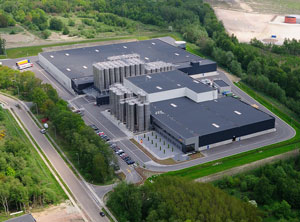SABIC IP
Raising “Stamax” long glass-fibre PP composites output in Belgium / Meeting rising demand from the automotive sector
 The new line is due on stream in 2013 (Photo: Sabic IP) |
In order to meet increased demand from automotive customers, Sabic Innovative Plastics (Sabic IP, Bergen op Zoom / The Netherlands; www.sabic-ip.com) plans to raise capacity for its “Stamax” long glass-fibre filled PP composite resins in Genk / Belgium. Production on the new line began in June 2012 and is scheduled for completion in H2 2013. By the time this article went to press, Plasteurope.com had not yet received a reply to its query about investment costs and exact capacity.
Leon Jacob, head of Sabic IP’s Automotive business in Europe, said the Genk facility – which came on stream in mid-2010 (see Plasteurope.com of 18.06.2010) – was built with scalability in mind. “It took only two years before we needed to scale up with this new, state-of-the-art production line because our Stamax composite resins have become a material of choice for a growing number of automotive applications,” he added.
Stamax’s properties, including its light weight, make it particularly suitable for automotive applications. According to Sabic IP, “making 200,000 front-end modules with Stamax resins vs. a PA hybrid solution could save enough energy to power 14,900 homes in Europe for one year.” The material already is widely used in front-end and door modules as well as seating structures and increasingly is making headway in tailgate applications as well as under the hood.
Last year Sabic IP opened the doors of another Stamax production plant in Bay St. Louis, Mississippi / USA to serve the growing needs of its North American automotive customers – see Plasteurope.com of 04.11.2011.
Leon Jacob, head of Sabic IP’s Automotive business in Europe, said the Genk facility – which came on stream in mid-2010 (see Plasteurope.com of 18.06.2010) – was built with scalability in mind. “It took only two years before we needed to scale up with this new, state-of-the-art production line because our Stamax composite resins have become a material of choice for a growing number of automotive applications,” he added.
Stamax’s properties, including its light weight, make it particularly suitable for automotive applications. According to Sabic IP, “making 200,000 front-end modules with Stamax resins vs. a PA hybrid solution could save enough energy to power 14,900 homes in Europe for one year.” The material already is widely used in front-end and door modules as well as seating structures and increasingly is making headway in tailgate applications as well as under the hood.
Last year Sabic IP opened the doors of another Stamax production plant in Bay St. Louis, Mississippi / USA to serve the growing needs of its North American automotive customers – see Plasteurope.com of 04.11.2011.
26.07.2012 Plasteurope.com [222956-0]
Published on 26.07.2012

 German version of this article...
German version of this article...